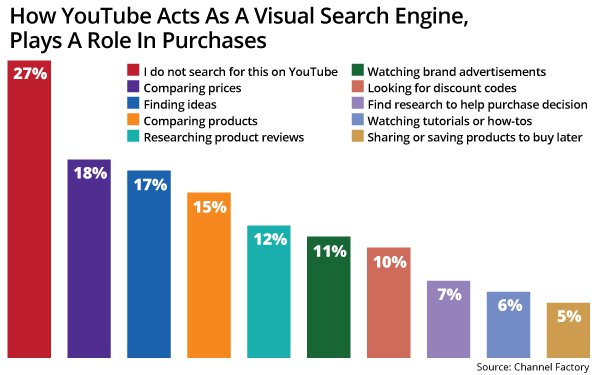
YouTube videos have made it easy for
consumers to quickly move from browsing to purchasing. The transition is being supported not only by videos, but also ads.
Forty-six percent of consumers said they have purchased a product
discovered on YouTube, and most did so within two weeks, according to a report from Channel Factory, a technology company that ensures ads are placed next to contextual relevant content.
Ads
drive the biggest uplift in market engagement. Nearly 46% of consumers buy products they discover on YouTube, spending $258 on average.
One in three shoppers purchase after seeing a YouTube
ad, with the average spend at $141.00 vs. one in five after seeing creator content spending $117.00 on average.
YouTube Shorts at 23% is the most persuasive format, followed by long videos at
12%, pre- and mid-roll ads at 12%, and livestreams at 7%, according to the report.
advertisement
advertisement
Channel Factory’s global study of more than 13,000 consumers across nine retail markets reveals how
YouTube shapes the shopping journey, from Thanksgiving and Black Friday to Christmas, New Year, and Diwali.
YouTube has
become a full-funnel platform where inspiration sparks intent, and intent rapidly turns into action, Rodrigo Paolucci, Global Head of Marketing at Channel Factory, told MediaPost.
For fashion
and other apparel, YouTube is a primary source of inspiration and price comparison. Nearly one in five consumers said they use YouTube to compare prices. Another 17% said they use it for inspiration
and styling tips.
But data shows YouTube is particularly effective for fashion, homeware, consumer electronics, food and drink, and travel because these sectors benefit from visual
storytelling.
Purchases can occur after seeing a video at any point from immediately after to several weeks. About 5% of consumers surveyed said they purchase immediately, while 11%
purchase within 14 days regardless of the category, and 17% purchase within two to six weeks.
Only 1% said they wait longer than a month. That short window highlights how vital timing,
relevancy, and contextual alignment are in driving fast sales.
AI is shaping what consumers see on YouTube, but people still strongly prefer human-created content when making purchase
decisions. About 43% of consumers favor ads or videos made by humans, compared with just 7% who prefer AI-generated content. Twenty-three percent said they don’t mind either way -- AI-generated
or human-generated -- and 17% like a mix of both.
Regardless of whether it’s human-created or AI-generated, the aim for any content is to engage its user. The preference for
human-created content over AI-generated content is also consistent across all age groups and genders, highlighting that authenticity and consistent quality remain key to building trust and
loyalty.